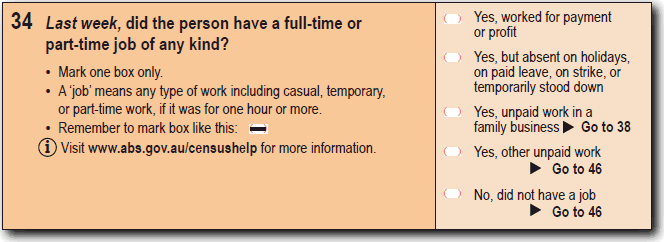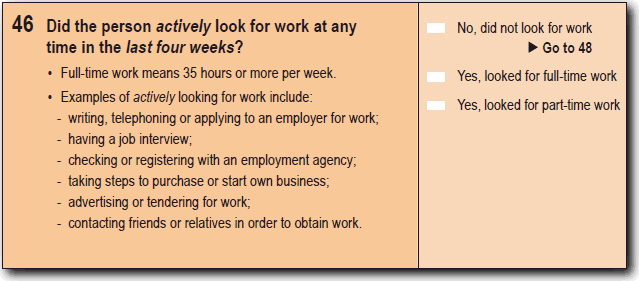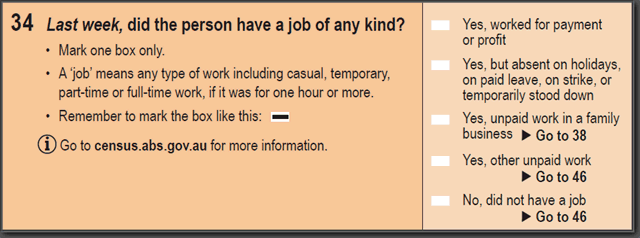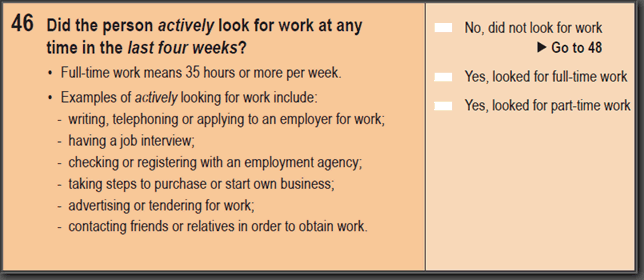Labour Force Status (LFSP)
This variable records a person's labour force status for the week prior to Census night. This variable is applicable to all persons aged 15 years or older.
How this variable is created
Labour Force Status is derived from responses to a number of questions on the Census form. Data is captured automatically from four mark box responses and from the written numeric response from the question asking how many hours a person worked. Occupation information may sometimes be used. Images of these questions are provided below.
Variable history
Questions relating to Labour Force Status were first asked in the 1911 Census with response categories revised in 2006 to align more closely with ABS labour force concepts.
Minor changes were made in 2016 to two of the five questions that contribute to the Labour Force Status variable. Minor changes were also made to the instructions on the online Census Household form. The 2016 text only version of the online form is available from the Downloads tab.
The 2011 question asked if the person had a full-time or part-time job last week, while 2016 just asks if they had a job of any kind. This change was to simplify the question and improve data quality.
2011 question

2016 question

In 2016, the question was re-formatted to emphasise the word '
actively' using italics and to provide examples of what 'actively looking for work' includes. Note also the inclusion of a definition of full time work.
2011 question

2016 question

Non-response rate
Non-response rate only applies to data items that directly reflect responses to individual Census form questions. Labour force status does not have a non-response rate as it is a derived value created during Census processing for applicable persons. For more information, refer to
Understanding Census data quality.
Data usage notes
2011 versus 2016 Census data comparison
Table 1 below shows the number of people counted across the Labour Force Status question categories in 2011 and 2016. Minor changes to questions, as described above, may have resulted in some differences in reporting between 2011 and 2016.
Table 1 Labour force status counts in 2011 and 2016.
|
 |  | Census 2011 |  | Census 2016 |
|
 |  | Number of Persons | % |  | Number of Persons | % |
Employed, worked full-time |  | 6,367,555 | 38.9% |  | 6,623,065 | 37.3% |
|
Employed, worked full-time |  | 3,062,977 | 18.7% |  | 3,491,503 | 19.6% |
|
Employed, away from work |  | 627,798 | 3.8% |  | 569,276 | 3.2% |
|
Employed Total |  | 10,058,325 | 61.4% |  | 10,683,842 | 60.1% |
|
Unemployed, looking for full-time work |  | 357,871 | 2.2% |  | 447,650 | 2.5% |
|
Unemployed, looking for part-time work |  | 242,264 | 1.5% |  | 339,804 | 1.9% |
|
Unemployed Total |  | 600,134 | 3.7% |  | 787,452 | 4.4% |
|
Labour Force |  | 10,658,456 | 65.0% |  | 11,471,294 | 64.6% |
|
Not in the labour force |  | 5,729,306 | 35.0% |  | 6,297,600 | 35.4% |
|
Total |  | 16,387,766 | 100.0% |  | 17,768,892 | 100.0% |
Community Development Programme
The 2006 and 2011 Interviewer Household Forms (IHF), which were used in discrete Aboriginal and Torres Strait Islander communities, included a category for those participating in the Community Development Employment Projects scheme. In 2016, the form was updated to include a response category for people who participated in the 2016 Community Development Programme. A person's response to the question on the Interviewer Household Form, in conjunction with responses to other labour force questions on the form, were used to assign a labour force status.
As part of the changes from Community Development Employment Projects (CDEP) scheme in 2011 to Community Development Programme (CDP) in 2016, payment arrangements for participants were changed, which changed the nature of their labour force status.
For more information about the Community Development Programme and how the classification of labour force for participants has changed, see the data quality statement for Community Development Programme Participation and the Glossary entry in the 2016 Census Dictionary.
Comparing Census with ABS Labour Force Survey
The Census of Population and Housing (Census) and Labour Force Survey (LFS) both collect information about the labour market activity of people aged 15 years and over. While both collections seek to measure the concepts related employment, unemployment and being outside of the labour force, there are a number of differences between them that should be considered in the use of the data.
For further information on the use of Census labour force data compared with data from the Labour Force Survey, and differences between the collections, see the 2016 Census and the Labour Force Survey page in this publication.
Further information
A definition of Labour Force Status is available in the 2016 Census Dictionary.
For more information related to Labour Force Statistics, see data quality statements for Hours Worked and Labour Force Status and Hours Worked Not Stated.
Household form question image
Questions 34, 44, 46, and 47 as they appeared on the 2016 Census Household Paper Form:





A text only version of the online Census Household form is available from the Downloads tab.
 Print Page
Print Page
 Print All
Print All